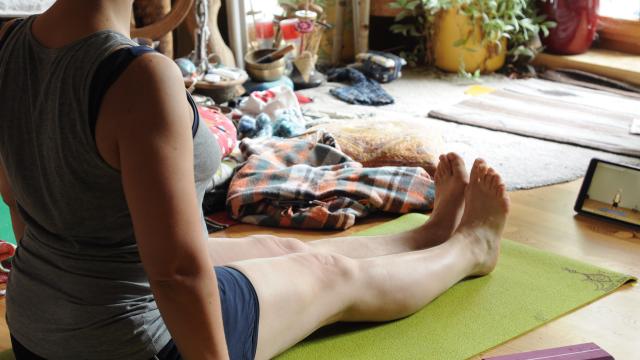The post-birth belly bulge is common — diastasis recti (DR), the medical term for the separation of the abdominal muscles, occurs in 37 per cent of women who have one pregnancy and 67 per cent of those who have multiple pregnancies. Still, that doesn’t make it less distressing for women, both physically and psychologically. I did not enjoy looking pregnant when my baby was very much outside of my body and already starting on solid foods.
Photo: distelfliege/Flickr
A recent NPR story is hailing a quick-ish fix for the condition. The tabloid-esque headline squeals, “Flattening the ‘Mummy Tummy’ With 1 Exercise, 10 Minutes a Day.” A fitness coach and doctor have come up with a technique that can shrink the dreaded “mummy pooch” — it involves keeping your back flat, sucking in your belly muscles toward the spine, and then taking tiny breaths, pushing the stomach back further and further with each exhale. Women claim they have seen “amazing” results after just three weeks.
While the exercise may very well help shave centimetres off the belly circumference, some physical therapists have concerns about the NPR piece, which reads a bit like a too-good-to-be-true infomercial.
“First of all, just no,” writes Jessica Dufault, the owner Mindful Motion Physical Therapy in Madison, Wisconsin. “It is a major disservice to tell women that one exercise for only a FEW minutes a day will fix DR. What about how we are using our bodies the other 23 hours and 50 minutes? I think it is way more important to consider how we sit, stand, carry babies, lift weights, bend, squat, and carry car seats! It isn’t about ‘exercising’ the core but rather about ‘re-training’ the core. I have worked with many clients with DR and I am certain it isn’t a simple or quick fix.”
Dufault believes the idea that we just need to “suck in” more needs to go.
Sucking in on the tummy muscles can do more harm than help. Think about squeezing the center of a balloon. If we create excess tension in the center, where does the pressure in the balloon go? Up and down. Either direction is problematic, but especially concerning is down due to pressure and stress on the pelvic organs and pelvic floor.
She believes that we need to change the culture around the “flat is fit” mentality, and instead focus on being functionally strong.
Fitness writer Nicole Radziszewski had similar concerns.
Diastasis recti is not simply an abs issue. It is a full-body alignment and pressure systems issue. Which is why unfortunately, doing one exercise for 10 minutes a day is not enough. Let’s say you do a few sets of an exercise that brings your rectus abdominus muscles closer together, but then you spend the remainder of your day standing with your ribs flared and sucking in your stomach — both things that increase the pressure on the linea alba and contribute to diastasis recti. Your alignment and breathing patterns just undid whatever you accomplished through your core training.
Both women urge mums who suspect they have DR to talk to a physical therapist. A PT may help with postural training, stretching, bracing, and teaching you how to perform daily activities, such as lifting and carrying your baby, while using proper posture. Dufault is also a proponent of home systems such as Restore Your Core and One Strong Mama.
As for the “Mummy Tummy” exercise, Dufault tells me, “I wish it were that easy. Truly I do!”

Comments